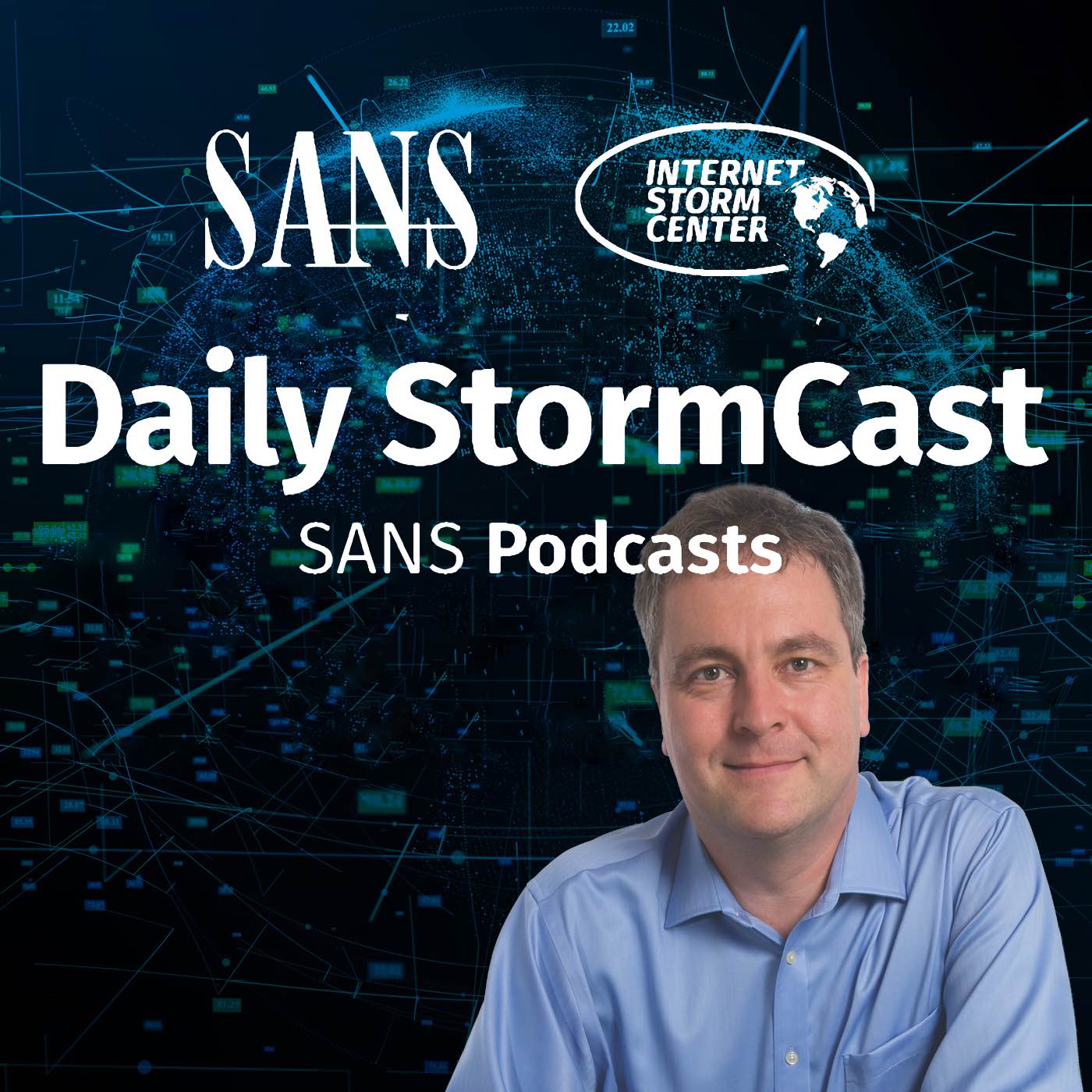Handler on Duty: Didier Stevens
Threat Level: green
Podcast Detail
SANS Stormcast Wednesday, July 23rd, 2025: Sharepoint 2016 Patch; MotW Privacy and WinZip; Interlock Ransomware; Sophos Patches
If you are not able to play the podcast using the player below: Use this direct link to the audio file: https://traffic.libsyn.com/securitypodcast/9538.mp3

Sharepoint 2016 Patch; MotW Privacy and WinZip; Interlock Ransomware; Sophos Patches
00:00
My Next Class
| Application Security: Securing Web Apps, APIs, and Microservices | Orlando | Mar 29th - Apr 3rd 2026 |
| Network Monitoring and Threat Detection In-Depth | Amsterdam | Apr 20th - Apr 25th 2026 |
Microsoft Updates SharePoint Vulnerability Guidance CVE-2025-53770 and CVE-2025-53771
Microsoft released its update for SharePoint 2016, completing the updates across all currently supported versions.
https://msrc.microsoft.com/blog/2025/07/customer-guidance-for-sharepoint-vulnerability-cve-2025-53770/
WinZip MotW Privacy
Starting with version 7.10, WinZip introduced an option to no longer include the download URL in zip files as part of the Mark of the Web (MotW).
https://isc.sans.edu/diary/WinRAR%20MoTW%20Propagation%20Privacy/32130
Interlock Ransomware
Several government agencies collaborated to create an informative and comprehensive overview of the Interlock ransomware. Just like prior writeups, this writeup is very informative, including many technical details useful to detect and block this ransomware.
https://www.cisa.gov/news-events/cybersecurity-advisories/aa25-203a
Sophos Firewall Updates
Sophos patched five different vulnerabilities in its firewalls. Two of them are critical, but these only affect a small percentage of users.
https://www.sophos.com/en-us/security-advisories/sophos-sa-20250721-sfos-rce
Discussion
New Discussions closed for all Podcasts older than two(2) weeks
Please send your comments to our Contact Form
| Application Security: Securing Web Apps, APIs, and Microservices | Orlando | Mar 29th - Apr 3rd 2026 |
| Network Monitoring and Threat Detection In-Depth | Amsterdam | Apr 20th - Apr 25th 2026 |
| Application Security: Securing Web Apps, APIs, and Microservices | San Diego | May 11th - May 16th 2026 |
| Network Monitoring and Threat Detection In-Depth | Online | Arabian Standard Time | Jun 20th - Jun 25th 2026 |
| Network Monitoring and Threat Detection In-Depth | Riyadh | Jun 20th - Jun 25th 2026 |
| Application Security: Securing Web Apps, APIs, and Microservices | Washington | Jul 13th - Jul 18th 2026 |
| Application Security: Securing Web Apps, APIs, and Microservices | Online | British Summer Time | Jul 27th - Jul 31st 2026 |
| Application Security: Securing Web Apps, APIs, and Microservices | Las Vegas | Sep 21st - Sep 26th 2026 |
Podcast Transcript
Hello and welcome to the Wednesday, July 23rd, 2025 edition of the SANS Internet Storm Center's Stormcast. My name is Johannes Ullrich, recording today from Jacksonville, Florida. And this episode is brought to you by the SANS.edu Bachelor's Degree Program in Applied Cybersecurity. SharePoint is still at the top of everybody's mind and the tool shell vulnerability is still being exploited. Microsoft has now also released an update for SharePoint 2016. Yesterday, we only had the update for 2019 and for the subscription edition. Another thing to point out here, there are actually two files that need to download and apply for 2019 and 2016. The first one is the security update for SharePoint itself. And then there is a second one, the language pack. When you install the security update for Microsoft SharePoint, you will have to reboot your system and then you'll apply the language pack. The language pack update does not require another reboot, but you can't apply them at the same time. Try it to save some time and, well, they're actually then failing. So, make sure you apply one after the other. There's another thing that I think has been a little bit overlooked in all of this. And that's step four here in Microsoft's response timeline that they published. There's part of this update. The early exploits that were used against SharePoint that took advantage of this vulnerability, they all had in common that they stole the system machine keys. And, well, that's actually a common thing to do if you're exploiting a .NET application. Because if you do have the machine keys, you can then fake a view state. And, essentially, you can come back and exploit the system again. So, if you're just updating the patch and removing any backdoors or web shells or other files that you may find that an attacker may have created, this is not sufficient if the attacker stole the machine keys. You must update the machine keys. Otherwise, you're opening yourself up to a repeat compromise. And the Didier found an interesting little privacy issue that comes up if you're using WinZIP 710 or later. The issue here is, well, the good old mark of the web. I'm mentioning this at least like once a week or so here on the podcast. But, typically, on Windows, the mark of the web, it includes a zone ID 3 for indicating that the file was downloaded from the Internet. And then it also typically includes the URL it was downloaded from. Well, that, of course, is something that you may not necessarily tell people that you're sending files to. So, WinZIP now has the option, and that's the default setting, to only include the zone value. So, the recipient of a zip file, including files that were downloaded from the Internet, will still know that, hey, these files were downloaded from the Internet. But they will no longer be able to see what website the particular file was downloaded from. You can uncheck this particular value, and then it will behave just like it used to in older versions. And the FBI, with other government agencies, has published a nice write-up about the interlock ransomware. CISA and FBI have done this a number of times in the past for various ransomware groups. This is not usually because this particular malware is brand new, but because it is sort of one of the dominating ransomware samples that they're seeing these days. It has very nice, hands-on information about how to detect and how to prevent this particular ransomware. Apparently, this ransomware often arrives as, essentially, a fake browser update. And as that is then being installed by the user. So, not so much hoping for technical exploits here. They're also using the famous click-fix technique, where, essentially, the user is tricked into copy-pasting some PowerShell code into their system. Well, with sort of the pretense of having to bypass CAPTCHA in order to move on to the next page. And Sophos released an update for its firewalls, fixing a total of five different vulnerabilities, two of which are rated critical by Sophos. One of the critical vulnerabilities is an arbitrary file write vulnerability that may lead to arbitrary code execution without authentication. The next critical one is SQL injection vulnerability in their transparent SMTP proxy, which they call a legacy feature. Both of these vulnerabilities only apply to very specific features. For example, the arbitrary file upload vulnerability only applies to devices in high -availability mode. And, well, Sophos thinks that's only 0.05 % of devices. Same for the SQL injection vulnerability. This SMTP proxy is a legacy feature. And Sophos thinks only 0.73% of users have this feature enabled. So, get it updated. You never know if you're going to enable one of those features by mistake or maybe intentionally and get it out of the way. Also, some of these high vulnerabilities and such are probably things that you should better update. Well, and that's it for today. So, thanks again for listening and talk to you again tomorrow. Bye.










